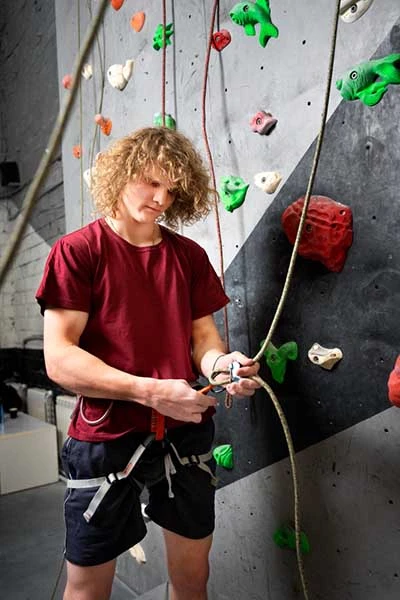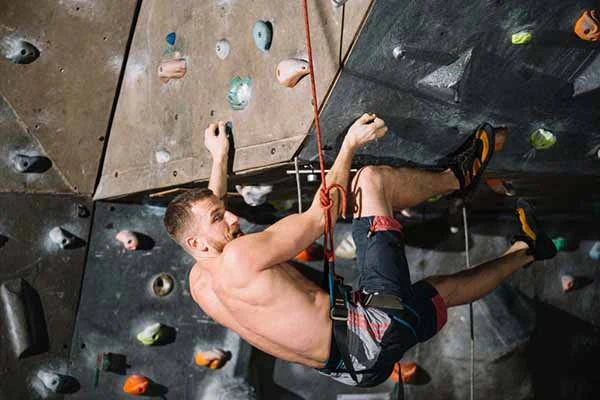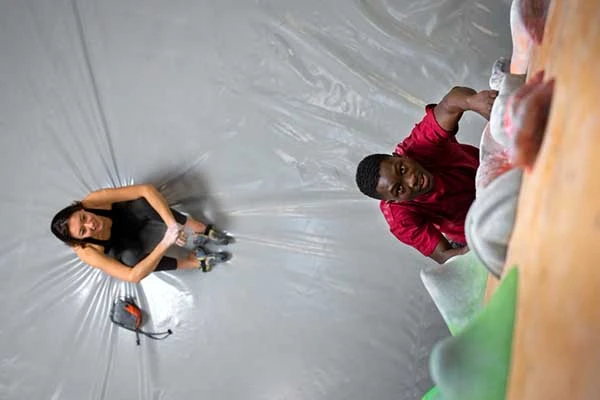Is indoor rock climbing safe? The answer is very simple that is “YES”. But before getting started read the whole article carefully. Indoor rock climbing has become increasingly popular in recent years as both a recreational activity and a competitive sport.
Climbers scale artificial rock walls or structures within a controlled environment, such as a climbing gym, using their strength, agility, and problem-solving skills.
This challenging activity provides a full-body workout and is suitable for all ages and fitness levels.
Additionally, indoor rock climbing is a great way to build confidence, improve flexibility, and meet new people in a supportive community. Whether you’re a beginner or a seasoned climber, indoor rock climbing offers a thrilling and rewarding experience.
Benefits of Indoor Rock Climbing
Indoor rock climbing is a fantastic way to improve your physical and mental well-being. It offers a complete workout for your entire body, helping to build strength, flexibility, and balance.
It challenges your problem-solving skills as you navigate different routes and obstacles, and can help boost your confidence and self-esteem as you conquer new challenges. Overall, indoor rock climbing is a great way to improve your overall health and well-being.
Safety Measures in Indoor Rock Climbing
Safety is paramount in indoor rock climbing to minimize the risk of accidents and injuries. Several measures ensure a safe climbing experience:

Proper equipment: Climbers should always use the appropriate safety gear, including harnesses, helmets, and climbing shoes. These items are designed to protect climbers in the event of a fall or other accident.
Proper training: Climbers need to receive proper training and instruction before attempting to climb indoors. This includes learning how to properly use equipment, understanding climbing techniques, and being aware of potential risks.
Supervision: Climbers should always be supervised by a knowledgeable and experienced individual, especially if they are new to indoor rock climbing. This helps to ensure that climbers are following safety protocols and can receive assistance if needed.
Inspections: Regular inspections of climbing walls, holds, and equipment by trained staff help ensure their safety and functionality.
Spotting: Having a trained spotter or belayer is essential to prevent falls and minimize the impact of any slips or mistakes.
Communication: Clear and effective communication between climbers and belayers is crucial for ensuring a safe climbing experience.
If you are going to start rock climbing at home then you must also know about different grips used in rock climbing.
Training and Supervision
Indoor rock climbing can be a thrilling and challenging activity, but it’s important to be properly trained before attempting it.
Learning climbing techniques, safety protocols, and equipment usage is crucial for a safe and enjoyable experience. Novice climbers should also be supervised by experienced instructors or climbers to ensure they are climbing safely and effectively.
Taking the time to receive proper training and supervision will help climbers build the skills and confidence needed to enjoy indoor rock climbing to the fullest.
Equipment Inspection and Maintenance
Regular inspection and maintenance of climbing equipment is crucial in ensuring the safety of all climbers. This includes checking harnesses, ropes, carabiners, and climbing holds for any signs of wear or damage that could potentially lead to accidents.
By conducting routine checks, climbers can identify and address any issues before they become a safety concern.
It’s important to follow manufacturer guidelines for inspection and maintenance to ensure that all equipment is in proper working condition.
Overall, staying vigilant in monitoring climbing gear is essential for a safe and enjoyable climbing experience.
Understanding Risks in Indoor Rock Climbing
It’s important to be aware of the potential risks associated with indoor rock climbing to ensure a safe and enjoyable experience. While indoor climbing facilities take numerous safety precautions, accidents can still occur.

It’s crucial to follow proper safety protocols, use reliable equipment, and receive thorough instruction before attempting any climbs.
Additionally, being mindful of your physical limitations and taking regular breaks can help prevent overexertion and potential injury. By being informed and cautious, you can minimize the risks and make the most of your indoor rock climbing experience.
Common Injuries and Prevention
It’s important to be aware of common injuries in indoor rock climbing, such as strains, sprains, abrasions, and fractures.
To reduce the risk of these injuries, climbers should always warm up properly before starting their climb, and use correct techniques to minimize strain on their muscles and joints.
Wear appropriate footwear with good grip and support, and avoid pushing themselves beyond their physical limits. Taking these precautions can help climbers stay safe and enjoy their indoor rock climbing experience.
Importance of Proper Warm-up and Cool-down
It’s important to have a proper warm-up routine before climbing to help prepare your body for the physical activity.
This can include gentle stretching, cardio exercises, and dynamic movements to increase blood flow to the muscles and improve flexibility.
Similarly, a cool-down session after climbing can help prevent muscle soreness and stiffness by allowing your body to gradually return to its resting state. This can include gentle stretching, foam rolling, and other relaxation techniques.
Both warm-up and cool-down routines are essential for maintaining and improving your climbing performance while reducing the risk of injury.
Role of Qualified Instructors
Qualified instructors are essential for maintaining safety during indoor rock climbing sessions. Their expertise allows them to provide guidance, instruction, and supervision to climbers, ensuring that proper techniques are being used and safety protocols are being followed.

Instructors also monitor climber progress and are prepared to intervene in case of emergencies, making their presence crucial for a safe and enjoyable climbing experience.
Emergency Preparedness
Indoor climbing facilities should have emergency protocols in place, including first aid kits, emergency contact information, and evacuation procedures. Climbers should familiarize themselves with these protocols before climbing.
Indoor climbing facilities should prioritize safety by having emergency protocols in place. This includes having readily accessible first aid kits, prominently displayed emergency contact information, and clear evacuation procedures.
Climbers need to familiarize themselves with these protocols before beginning their climb to ensure they are prepared in case of an emergency.
Health Conditions and Precautions
Individuals with pre-existing health conditions such as heart problems, high blood pressure, or orthopedic issues should consult their healthcare provider before engaging in indoor rock climbing. They should also inform instructors about any medical concerns.
Individuals with pre-existing health conditions like heart problems, high blood pressure, or orthopedic issues need to consult with their healthcare provider before trying indoor rock climbing.
It’s also a good idea to inform instructors about any medical concerns so they can provide appropriate guidance and support during the activity. Prioritizing safety and taking necessary precautions will help ensure a positive and enjoyable experience.
Psychological Aspect of Fear
Indoor rock climbing requires overcoming fear, as it is a natural part of the sport. However, climbers can learn to manage their fear through gradual exposure, positive reinforcement, and mental conditioning techniques.
This allows them to build confidence and ultimately improve their climbing abilities.
Conclusion: Is Indoor Rock Climbing Safe?
Indoor rock climbing can be a safe and rewarding activity when proper precautions are taken. By following safety measures, undergoing training, and exercising caution, climbers can enjoy the physical and mental benefits of this exhilarating sport.
It’s important to always prioritize safety and be mindful of your surroundings while climbing. With the right preparation and a focus on safety, indoor rock climbing can be a fun and fulfilling activity for people of all skill levels.
FAQs: Is Indoor Rock Climbing Safe?
Is indoor rock climbing suitable for beginners?
Yes, indoor rock climbing is suitable for beginners. Most indoor climbing gyms offer introductory classes and have beginner-friendly routes that are designed to help new climbers learn the basics and build their skills in a safe and supportive environment. Additionally, indoor climbing walls are equipped with safety features such as harnesses, ropes, and crash pads to help minimize the risk of injury for beginners. With proper instruction and supervision, indoor rock climbing can be a fun and accessible activity for people of all skill levels.
What should I wear for indoor rock climbing?
You should wear comfortable, flexible clothing that allows for a full range of motion. Many people opt for athletic leggings or shorts and a moisture-wicking top. It’s also important to wear closed-toe athletic shoes with good traction. Additionally, consider bringing a chalk bag to help keep your hands dry while climbing. And don’t forget to remove any jewelry or accessories that could get caught on the climbing holds.
Are there age restrictions for indoor rock climbing?
Yes, there are age restrictions for indoor rock climbing. Most indoor rock climbing facilities have specific age requirements for children, typically starting at around 4-5 years old. Some facilities may have a minimum age requirement for participants, while others may have different age restrictions for certain climbing areas or activities. It’s important to check with the specific rock climbing facility for their age restrictions before planning a visit.
How often should I practice indoor rock climbing?
It is generally recommended to practice indoor rock climbing at least 2-3 times a week to see improvement in your skills and strength. However, the frequency of practice can vary depending on your individual fitness level, goals, and schedule. It’s important to listen to your body and give yourself enough time to rest and recover between sessions.
What if I’m afraid of heights?
It’s completely normal to be afraid of heights, and it’s a common fear for many people. If you’re feeling anxious about being in high places, it’s important to listen to your body and take steps to manage your fear. There are various techniques and therapies available to help overcome the fear of heights, such as exposure therapy, relaxation techniques, and cognitive-behavioral therapy. It’s also important to remember that it’s okay to take things at your own pace and seek support from friends or professionals if needed.


